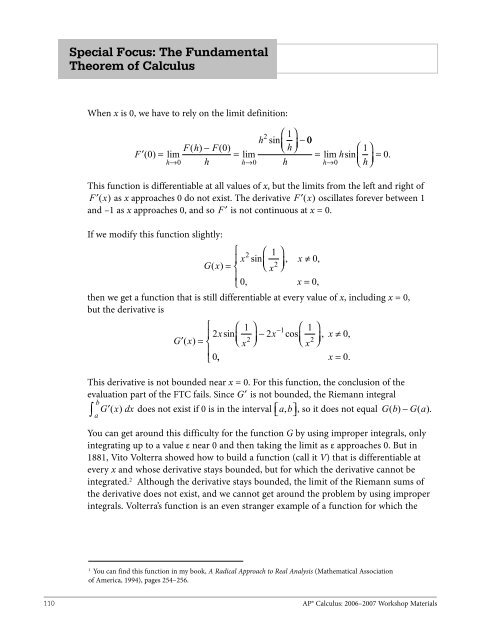AP Calculus
Create successful ePaper yourself
Turn your PDF publications into a flip-book with our unique Google optimized e-Paper software.
Special Focus: The Fundamental<br />
Theorem of <strong>Calculus</strong><br />
When x is 0, we have to rely on the limit definition:<br />
h<br />
F h − F<br />
F′ ( ) = lim ( ) ( 0<br />
0<br />
) = lim<br />
h→0 h h→0<br />
2<br />
⎛ 1⎞<br />
sin<br />
⎝<br />
⎜ h⎠<br />
⎟ − 0<br />
1<br />
= h 0<br />
h<br />
lim sin ⎛ ⎞<br />
h 0 ⎝<br />
⎜ h⎠<br />
⎟ = .<br />
→<br />
This function is differentiable at all values of x, but the limits from the left and right of<br />
F′<br />
( x) as x approaches 0 do not exist. The derivative F′<br />
( x) oscillates forever between 1<br />
and –1 as x approaches 0, and so F ′ is not continuous at x = 0.<br />
If we modify this function slightly:<br />
⎧<br />
2 ⎛ 1 ⎞<br />
⎪ x sin , x ,<br />
G( x)<br />
= ⎝<br />
⎜<br />
x ⎠<br />
⎟ ≠ 0<br />
2<br />
⎨<br />
⎪<br />
⎩ 0, x = 0,<br />
then we get a function that is still differentiable at every value of x, including x = 0,<br />
but the derivative is<br />
⎧ ⎛ 1 ⎞<br />
′ = ⎝<br />
⎜<br />
⎠<br />
⎟ − −1<br />
⎛ 1 ⎞<br />
⎪ 2xsin 2x<br />
cos<br />
⎝<br />
⎜<br />
⎠<br />
⎟ , x ≠ 0,<br />
G ( x)<br />
2<br />
2<br />
⎨ x<br />
x<br />
⎪<br />
⎩ 0, x = 0.<br />
This derivative is not bounded near x = 0. For this function, the conclusion of the<br />
evaluation part of the FTC fails. Since G ′ is not bounded, the Riemann integral<br />
b<br />
∫ G ′( x ) dx does not exist if 0 is in the interval ⎡⎣ a,<br />
b⎤ ⎦ , so it does not equal G( b) − G( a).<br />
a<br />
You can get around this difficulty for the function G by using improper integrals, only<br />
integrating up to a value ε near 0 and then taking the limit as ε approaches 0. But in<br />
1881, Vito Volterra showed how to build a function (call it V) that is differentiable at<br />
every x and whose derivative stays bounded, but for which the derivative cannot be<br />
integrated. 2 Although the derivative stays bounded, the limit of the Riemann sums of<br />
the derivative does not exist, and we cannot get around the problem by using improper<br />
integrals. Volterra’s function is an even stranger example of a function for which the<br />
1<br />
You can find this function in my book, A Radical Approach to Real Analysis (Mathematical Association<br />
of America, 1994), pages 254–256.<br />
110<br />
<strong>AP</strong>® <strong>Calculus</strong>: 2006–2007 Workshop Materials


